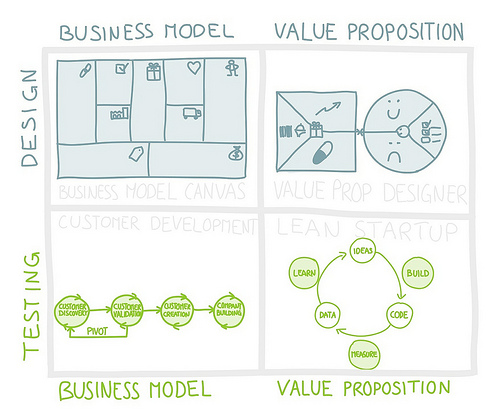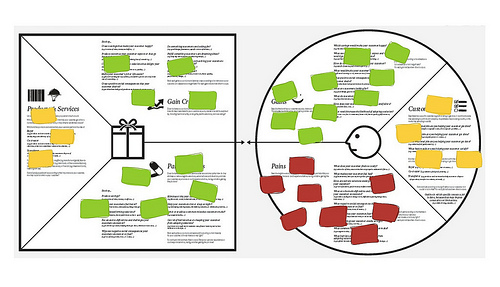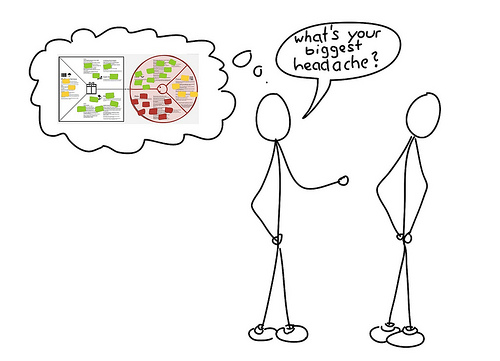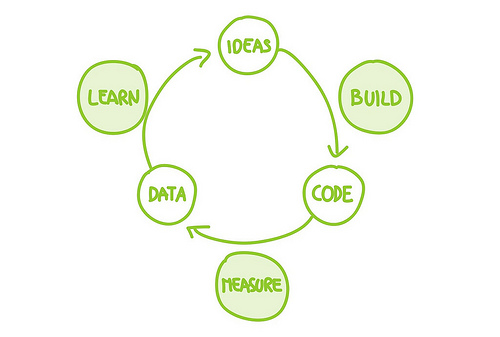Testing the proposed value using the principles of a lean start-up and client development
In my last post I described a new business tool - the Gavn of the proposed value. In this post I will tell you how you can use this tool not only to develop a value proposition, but also to test it. You will learn how to apply effective principles of a lean start-up and client development in designing, testing and building what consumers really want.
The outline of the proposed value allows you to examine in detail the value of your proposal and the needs of your target segments. To improve the value proposition, a poster (see image below) and stickers can be used in its development. At the same time, in order to make sure that consumers really need what you are developing, it is necessary to test all the assumptions that you put forward in Kanva of the proposed value.

')
We already know how to develop and test business models by combining Canva with a business model and client development process . Steve Blank vividly demonstrated this in his work .
We can do the same with the proposed value by combining Kanva with the proposed value and lean startup process. This will provide a more systematic approach to achieving what, in the context of a start-up movement, is called product-market matching or problem-solving — in other words, building / proposing what consumers really want.

In short, the process of a lean startup is actually a cycle consisting of “building” prototypes of products (and services), their “measuring” and “collecting information” with their help. Lean start-ups call such prototypes Minimum Viable Products (MVP) .
The outline of the proposed value can add to this process two key aspects that are currently missing, which will take us to a whole new level.
First, the outline of the proposed value provides a simple and practical way to quickly describe what you create, and what you think it will be valuable for consumers, as well as why you create it: which of the tasks, the minuses and advantages for consumers you are going to work.
By doing this BEFORE building the MVP, you can better monitor and control the process of testing, measuring and collecting information.

Secondly, the outline of the proposed value helps you to separate the notions of product assumptions / value propositions and consumer assumptions. If you “simply” build the MVP to measure and collect information, you will not know if the negative results of your experiment are related to your MVP or to the lack of interest from consumers.
In science, such a significant omission would make the results generally invalid. Therefore, it is necessary to separate the testing of their assumptions about the product / proposed value (ie, WHAT) and their assumptions about the consumer (ie WHY) wherever possible. The latter can be identified and investigated even before the development of MVP.
Let me take you through an exemplary step-by-step process of using Canva's proposed value in testing. In reality, of course, these steps will be less consistent and much more erratic. You will also want to adapt this process to your needs and conditions.
Describe the TASKS that the consumer is trying to accomplish with your product, as well as label the MINUSES and BENEFITS for your customer. List the PRODUCTS and SERVICES that you intend to offer, and describe how, in your opinion, they WILL SOFT MINUSES for your consumers and CREATE PLUSES. If you need help, you can use suggestive questions in the poster and my last blog post.

Voila, you now have an excellent list of assumptions about the product / proposed value and consumer. You have described who, in your opinion, are consumers, and what, in your opinion, will create value for them. This is your best guess, which for now is just your (rational) opinion.

Now, in the words of Steve Blanca, it’s time to “leave the offices” to test the assumptions about your consumer. Talk to as many potential customers as possible to see if they are really trying to complete the TASKS you described on the Canvas for the proposed value. Find out if these TASKS for them are vital or insignificant? Find out if they really are those MINUSES that you think they should be. Are these MINUSES strong or weak? Check if they really appreciate the BENEFITS that you think they should appreciate.

The more thoroughly you can test consumer assumptions, the better. I mean, you don’t just need to talk to consumers, but you shouldn’t build a MVP yet. Professional designers also use several methods.
Now that you have better known your consumers, you need to once again turn to the portrait of the consumer on the canvas of the proposed value. Ideally, now you understand the importance of the TASKS of your customers, the strength of the MINUSES and PLUSES of your product, as well as their DESIRE.

On the basis of information received from consumers, select the disadvantages and pros on which you want to focus. Next, change your proposed value accordingly. Do not forget that a good proposed value is rarely aimed at facilitating all MINUSES for the consumer and providing him with all the PLUSES. She really pays great attention to only a few of them!

So you will get the corrected Canvas of the proposed value.

Now it's time to build your MVP and continuously test and change the value you offer based on the information you collect.

The outline of the proposed value will serve as a map for you to keep track of assumptions and tests while advancing the process of a lean startup. This cycle will end at the moment when you achieve a match between the value you offer and the expectations of consumers. This is what, within the framework of the movement of lean startups, is called product matching the market or problem solving - when you do what consumers really want!

Feel free to leave your feedback, as this process is just the first recommendation on how to use the Canvas of the proposed value.
The translation was made as part of the Tolstoy Summer Camp start-up summer school.
The outline of the proposed value allows you to examine in detail the value of your proposal and the needs of your target segments. To improve the value proposition, a poster (see image below) and stickers can be used in its development. At the same time, in order to make sure that consumers really need what you are developing, it is necessary to test all the assumptions that you put forward in Kanva of the proposed value.

')
We already know how to develop and test business models by combining Canva with a business model and client development process . Steve Blank vividly demonstrated this in his work .
We can do the same with the proposed value by combining Kanva with the proposed value and lean startup process. This will provide a more systematic approach to achieving what, in the context of a start-up movement, is called product-market matching or problem-solving — in other words, building / proposing what consumers really want.

In short, the process of a lean startup is actually a cycle consisting of “building” prototypes of products (and services), their “measuring” and “collecting information” with their help. Lean start-ups call such prototypes Minimum Viable Products (MVP) .
Lean Startup Process Usage
The outline of the proposed value can add to this process two key aspects that are currently missing, which will take us to a whole new level.
First, the outline of the proposed value provides a simple and practical way to quickly describe what you create, and what you think it will be valuable for consumers, as well as why you create it: which of the tasks, the minuses and advantages for consumers you are going to work.
By doing this BEFORE building the MVP, you can better monitor and control the process of testing, measuring and collecting information.

Secondly, the outline of the proposed value helps you to separate the notions of product assumptions / value propositions and consumer assumptions. If you “simply” build the MVP to measure and collect information, you will not know if the negative results of your experiment are related to your MVP or to the lack of interest from consumers.
In science, such a significant omission would make the results generally invalid. Therefore, it is necessary to separate the testing of their assumptions about the product / proposed value (ie, WHAT) and their assumptions about the consumer (ie WHY) wherever possible. The latter can be identified and investigated even before the development of MVP.
Step-by-step use of Canva's proposed value
Let me take you through an exemplary step-by-step process of using Canva's proposed value in testing. In reality, of course, these steps will be less consistent and much more erratic. You will also want to adapt this process to your needs and conditions.
1. Fill out the outline of the proposed value.
Describe the TASKS that the consumer is trying to accomplish with your product, as well as label the MINUSES and BENEFITS for your customer. List the PRODUCTS and SERVICES that you intend to offer, and describe how, in your opinion, they WILL SOFT MINUSES for your consumers and CREATE PLUSES. If you need help, you can use suggestive questions in the poster and my last blog post.

Voila, you now have an excellent list of assumptions about the product / proposed value and consumer. You have described who, in your opinion, are consumers, and what, in your opinion, will create value for them. This is your best guess, which for now is just your (rational) opinion.

2. Test consumer assumptions.
Now, in the words of Steve Blanca, it’s time to “leave the offices” to test the assumptions about your consumer. Talk to as many potential customers as possible to see if they are really trying to complete the TASKS you described on the Canvas for the proposed value. Find out if these TASKS for them are vital or insignificant? Find out if they really are those MINUSES that you think they should be. Are these MINUSES strong or weak? Check if they really appreciate the BENEFITS that you think they should appreciate.

The more thoroughly you can test consumer assumptions, the better. I mean, you don’t just need to talk to consumers, but you shouldn’t build a MVP yet. Professional designers also use several methods.
3. Correct your assumptions about the consumer based on information received from him.
Now that you have better known your consumers, you need to once again turn to the portrait of the consumer on the canvas of the proposed value. Ideally, now you understand the importance of the TASKS of your customers, the strength of the MINUSES and PLUSES of your product, as well as their DESIRE.

4. Change your proposed value based on the information received.
On the basis of information received from consumers, select the disadvantages and pros on which you want to focus. Next, change your proposed value accordingly. Do not forget that a good proposed value is rarely aimed at facilitating all MINUSES for the consumer and providing him with all the PLUSES. She really pays great attention to only a few of them!

So you will get the corrected Canvas of the proposed value.

5. Start testing the proposed value.
Now it's time to build your MVP and continuously test and change the value you offer based on the information you collect.

The outline of the proposed value will serve as a map for you to keep track of assumptions and tests while advancing the process of a lean startup. This cycle will end at the moment when you achieve a match between the value you offer and the expectations of consumers. This is what, within the framework of the movement of lean startups, is called product matching the market or problem solving - when you do what consumers really want!

Feel free to leave your feedback, as this process is just the first recommendation on how to use the Canvas of the proposed value.
The translation was made as part of the Tolstoy Summer Camp start-up summer school.
Source: https://habr.com/ru/post/186036/
All Articles